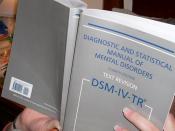Disorder Clarification & Case Analysis week 2
1 |
7 |
Disorder Clarification & Case Analysis week 2
Schizophrenia, mood affective disorder, and psychosis and suicide have a similar basis in the brain- individual's sufferings from it are not in the normal state of reality. Although physically, they may all look alright, "Two brain chemicals may interact to contribute to the development of psychotic disorders such as schizophrenia, according to a new study.
The results suggest abnormal levels of the neurotransmitter glutamate may lead to changes in the levels of another neurotransmitter, dopamine, causing the transition into psychosis". Although their symptoms may be similar, how they affect an individual biologically, emotionally and cognitively is very unique.
Schizophrenia: schizophrenia is a general term for a group of psychotic illness characterized by disturbed thinking, emotional reactions and behaviors.
It is the term for a group of mental disorders marked by a variety of symptoms. According to DSM-IV-TR, there are five characteristic symptoms of schizophrenia: delusion, hallucination, disorganized speech, grossly disorganized behavior and negative symptom. "A number of factors have been proposed as being linked to schizophrenia: genetic, psychological, endocrinological, metabolic, environmental, virological, and auto-immunological factors, as well as neurotransmitter systems and structural disorders of the brain. All may act as predisposing, triggering, or functionally modulating factors in what probably a condition composed of several types of disorder with varying aetiology. Neuroanatomical and neuromorphological data have revealed ventricular enlargement and diminished frontal and temporal lobe volume in some patients. These changes are concentrated particularly in the hippocampus/parahippocampal gyrus/amygdala, but are relatively small and span some overlap with healthy subjects. Twin studies suggest that at least some of these...


